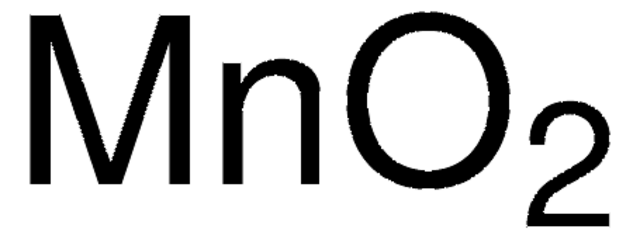637025
Cobalt(II,III) oxide
nanopowder, <50 nm particle size (SEM), 99.5% trace metals basis
Synonym(s):
Cobalt tetraoxide, Cobaltic-cobaltous oxide, Tricobalt tetraoxide
About This Item
Recommended Products
Assay
99.5% trace metals basis
form
nanopowder
surface area
40-70 m2/g , typical range
particle size
<50 nm (SEM)
mp
895 °C (dec.) (lit.)
density
6.11 g/mL at 25 °C (lit.)
bulk density
0.57 g/mL
application(s)
battery manufacturing
SMILES string
O=[Co].O=[Co]O[Co]=O
InChI
1S/3Co.4O
InChI key
LBFUKZWYPLNNJC-UHFFFAOYSA-N
Looking for similar products? Visit Product Comparison Guide
General description
Application
- To modify the glassycarbon electrode for the detection of As(III) at nanomolar concentrationrange.
- To prepare a robust photocatalyst along withcarbon nanospheres for dye degradation and hydrogen evolution reaction.
- As an electrodematerial in the preparation of supercapacitors.
Signal Word
Danger
Hazard Statements
Precautionary Statements
Hazard Classifications
Aquatic Chronic 3 - Carc. 1A Inhalation - Resp. Sens. 1
Storage Class Code
6.1C - Combustible acute toxic Cat.3 / toxic compounds or compounds which causing chronic effects
WGK
WGK 1
Flash Point(F)
Not applicable
Flash Point(C)
Not applicable
Choose from one of the most recent versions:
Already Own This Product?
Find documentation for the products that you have recently purchased in the Document Library.
Customers Also Viewed
Articles
Currently, magnetic nanoparticles (MNPs) are attracting a lot of attention because of the possibility of many novel applications, especially in biomedical research.
Graphene is a unique two-dimensional (2D) structure of monolayer carbon atoms packed into a dense honeycomb crystal that has attracted great interest due to its diverse and fascinating properties.
The application of magnetism and magnetic materials pervades our modern civilization in the form of electrical power, communications and information storage.
Magnetic materials permeate numerous daily activities in our lives. They are essential components of a diversity of products including hard drives that reliably store information on our computers, decorative magnets that keep the shopping list attached to the refrigerator door, electric bicycles that speed our commute to work, as well as wind turbines for conversion of wind energy to electrical power.
Our team of scientists has experience in all areas of research including Life Science, Material Science, Chemical Synthesis, Chromatography, Analytical and many others.
Contact Technical Service










